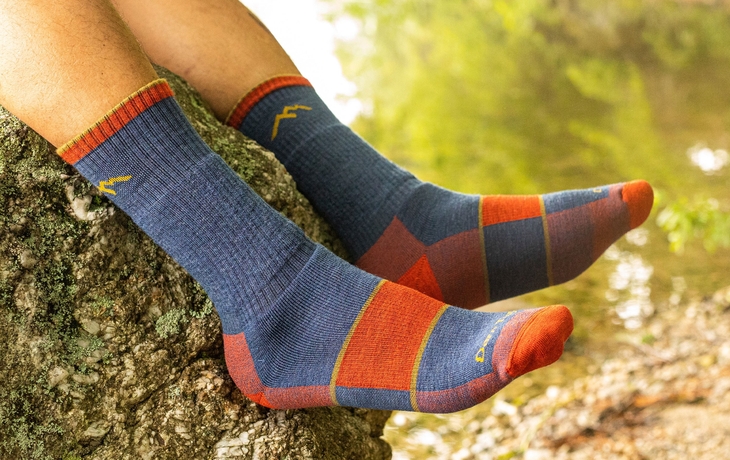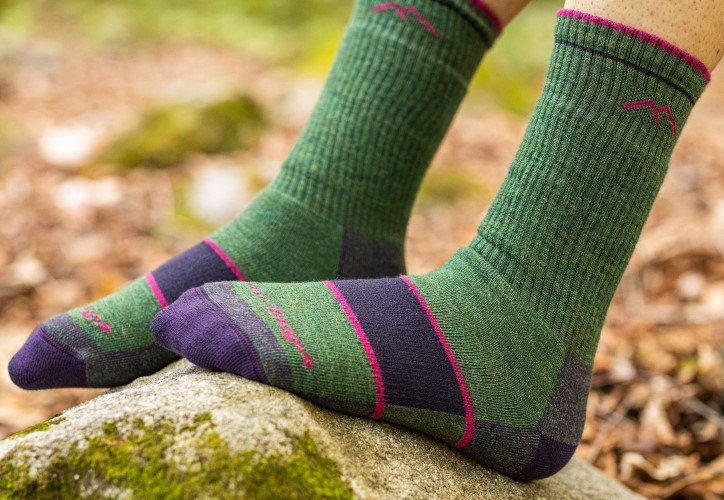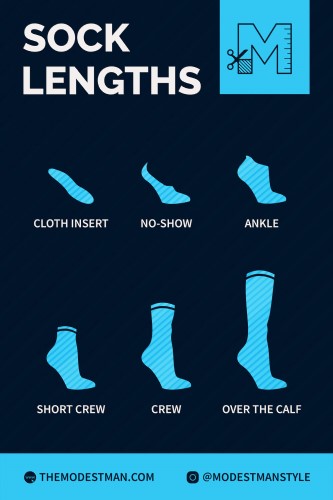Quality socks are expensive, between $20-30 a pair, but you don’t have to go out and replace your entire sock collection. Keep at least a pair or two in your go-bags in case you find yourself spending a lot of time on foot.
Merino wool is the best sock material for these purposes because it’s comfortable, works in any temperature, and thanks to its antimicrobial nature, can be worn for days at a time without getting stinky or moldy.
There are many great brands of sock, but experts recommend Darn Tough for most people. They’re universally beloved for their comfort, quality, and durability, and their lifetime warranty is unbeatable. There are other popular brands like SmartWool and FITS, but reviewers consistently rank Darn Tough as tougher and with a better warranty. For example, we’ve almost never had a personal pair of Darn Toughs wear out, yet almost every pair of SmartWools we’ve used have fallen apart after a surprisingly short amount of time.
The most important bits:
- Merino wool mixed with synthetic fibers is the best sock material as it’s antimicrobial, comfortable, warm even when wet, and somewhat fire resistant.
- Most experts prefer socks with more padding rather than less.
- But if you’re in a climate that is consistently hot (eg. Phoenix), you might want lighter “weights” that won’t suffocate your foot as much. Recent models also do a good job of putting cushion where it’s needed, such as under the heel, while then going minimal in the other areas to keep things cool.
- Longer socks that at least cover the ankle are preferred since they offer more protection.
- Socks obviously wear out, so durability and warranties are key criteria when picking brands.
- It’s often better to spend $20 on a great pair of socks rather than $10 each on two pairs of mediocre ones.
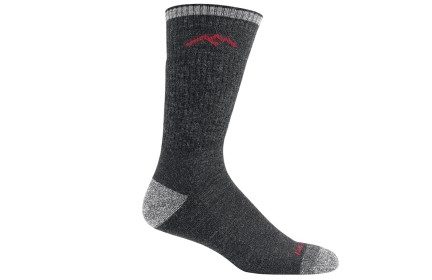
For Men:
Darn Tough Hiker
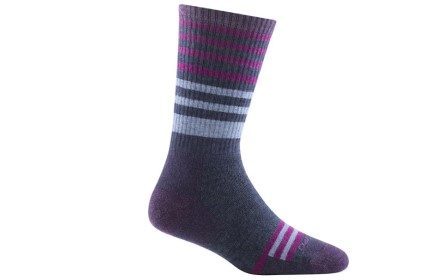
For Women:
Darn Tough Gatewood
Contenders
Although not currently top picks, these models are worth a look if you want more shopping options:
Be prepared. Don’t be a victim.
Want more great content and giveaways? Sign up for The Prepared’s free newsletter and get the best prepping content straight to your inbox. 1-2 emails a month, 0% spam.
Why socks are important
Good socks are a worthwhile investment, not just for outdoor activities and survival situations, but to your overall health. Here are some of the benefits good socks offer:
- They protect your feet from everyday stresses like pressure, impact, and shear forces.
- They protect your feet, which grow and shrink throughout the day, from the firm interior of your shoes or boots.
- They wick moisture, preventing blisters, foot fungus, and trench foot.
These are annoying or debilitating conditions in the best of times, but when you’re far from civilization and have to travel long distances on foot, they can be life threatening. If you’re bugging out, the last thing you want to deal with is foot pain or an infection. Keeping your feet clean, warm, and dry is essential, and good socks are key to that.
In freezing temperatures, socks are even more important. Your toes are especially susceptible to frostbite, as your body will divert blood flow from your extremities to keep your core temperature up. That risk increases if your toes are wet.
Keeping your feet warm and dry is also important in cold weather to keep your core temperature up. Your hands and feet are full of blood vessels called arterio-venous anastomoses that connect veins and arteries, and they are an important part of how your body regulates heat. In plain English, you tend to lose more heat through your hands and feet than the rest of your body.
Even if you wear normal cotton socks, you should keep a couple of pairs of good Merino wool socks in your go-bag in case you find yourself on foot.
Sock material
Most socks are made from cotton, and there really isn’t a worse material for socks. Podiatrists caution against cotton socks in the best of times because they retain moisture, bunch up, lose their shape over time, and become abrasive after multiple washes.
Many synthetic fibers are also bad for socks. If you’ve ever worn acrylic dress socks, you probably found your feet soaking wet at the end of the day, which can lead to infections and blisters. Synthetics can be especially problematic in outdoor scenarios because they can easily pinhole or melt when exposed to fire.
The best material for socks is wool. Wool is superior because:
- Wool repels water, at least to a certain degree
- Wool keeps your skin warm, even if wet
- Wool turns to harmless ash if burnt
- Wool is naturally antimicrobial, so wool socks don’t get germy, moldy, or smelly
More: Dress like a prepper: the wonders of wool/nylon blends
The preferred wool for socks (or pretty much anything these days) is Merino wool, which is an especially soft wool that comes from the Merino breed of sheep. However, pure Merino is somewhat fragile and pills up easily, so the best sock manufacturers blend Merino with a lesser amount of nylon or other synthetic to enhance the sock’s durability. That makes them a bit more susceptible to fire, but your socks are less likely to fall apart on the trail.
Sock construction
There are numerous varieties of socks. For preparedness purposes, you want socks advertised for hiking, backpacking, or mountaineering, with each one being an increment in thickness, with the mountaineering socks being the thickest, since they’re intended for cold weather. Since Merino wool is breathable even in warm weather, it’s not a bad idea to lean toward warmer socks if you’re unsure.
Socks also come in different lengths, all the way from socks so short that you look as though you’re wearing shoes without socks, to socks that reach your groin. Opt for “boot” or “over the calf” socks that work well with boots and cover more of your leg from the elements without being difficult to put on. You can always push them down if they’re too high.
Socks come either cushioned or uncushioned. Go for the cushioning. The cushioning helps prevent blisters.
Finally, you might need compression socks if you suffer from diabetes or other causes of leg pain or poor blood circulation in your lower legs. Darn Tough and others make compression socks that fit our other criteria.
Good sock brands and their warranties
Good socks have warranties. Although you may not be able to get a warranty exchange during a SHTF situation or while in the boonies, a manufacturer’s warranty gives you a clue as to how much confidence they have in their products:
- Minus33: 1 year warranty, 2 years if you register your socks. Doesn’t cover abuse.
- 5.11 Tactical: Guaranteed from defects as long as you own the product, but does not cover wear and tear or abuse.
- Darn Tough: Darn Tough, based out of Vermont, is the gold standard in quality socks. They offer an “unconditional lifetime guarantee,” which does actually have a few conditions: they don’t cover bite damage, fire damage, or lost socks.
- FITS: A favorite of Jon Stokes due to how they have tough nylon on the outside and soft Merino wool on the inside. They have a no-questions-asked two-year warranty.
- L.L. Bean: L.L. Bean sells several sock brands, including their own private label socks. You can return items purchased directly from L.L. Bean for up to one year, with a lifetime warranty for defects.
- REI Co-Op: Like L.L. Bean, REI sells several brands, and their own private label REI Co-Op brand, which tends to be high quality. And like L.L. Bean, REI allows returns for up to a year, with a lifetime guarantee against defects.
- SmartWool: Once a leader in outdoor gear, many are disappointed in the quality of their latest products. They completely guarantee their products for up to two years.
- Wigwam: Another popular brand with preppers, Wigwam covers manufacturing defects but not wear and tear.
Out of all of these, Darn Tough has the best guarantee by far.
